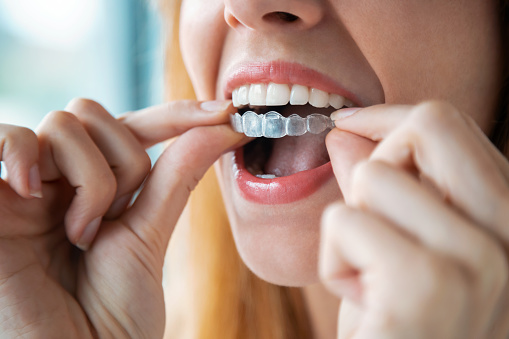Invisalign: What makes it popular among users?
Investing on getting your teeth fixed and upgraded brings more benefits on top of having a great smile. A dental treatment that has seen a spike in demand among adult users is Invisalign. This treatment works to correct and align each of the tooth’s placements.
Invisalign boasts of its easy-to-use feature: the clear aligners are not fixed to the teeth, unlike its braces counterparts. Considering aesthetics, Invisalign is highly favored over wires and brackets because of its transparent design.
So, what exactly is this Invisalign treatment and why is it popular nowadays? This article gives you the scoop.
Invisalign Overview
The Invisalign aligners use the latest innovation developed for creating an orthodontic treatment that focuses on straightening the teeth efficiently and effectively. Its system uses their very own SmartForce Technology to form sets of customized clear aligners that are worn over the teeth. These aligners deliver result by gradually shifting the teeth to their perfect position.
Schedule an appointment with your Invisalign-trained doctor
Only licensed dental doctors, which you can conveniently find on Dentaleh.com, that have undergone training to handle an Invisalign procedure, are allowed to do this type of treatment. You will know if a doctor has undergone Invisalign training when they can show you a certificate that signifies their course completion.
Invisalign has also created a “volume-based tier designation” to categorize the quantity of cases that dental practitioners have in performing this treatment. The tier system is divided into several categories, such as:
- Platinum Elite (PE)
- Platinum (P)
- Diamond (D)
- Black Diamond (BD)
Doctors who have reached the diamond level signify that they have surpassed 150+ cases of providing Invisalign treatment. The higher they go up the rank, the more you can be sure that you will be in good hands.
Conditions treated by Invisalign
Invisalign can treat various conditions that affect the teeth. These include:
- Overbite – Also known as “deep bite,” this occurs when the upper front teeth extend beyond the lower front teeth. This can weaken the health of your teeth.
- Underbite – The opposite of overbite, this happens when the lower teeth juts out and overlaps the upper teeth. Having an underbite can affect a person’s manner of grinding food and speaking. Invisalign can treat mild to moderate underbites, while severe cases can be treated in combination with surgery.
- Crossbite – A crossbite can be identified when a few if the upper teeth are situated inside the lower teeth when the mouth is closed. The ideal placement of the upper teeth is on the outside of the lower teeth, but not too far out. Crossbites can cause chipping of the teeth and receding gums.
- Gap Teeth – Spaces in between the teeth can trap particles of food in the gums, which can lead to soreness and disease. Invisalign can correct these spacing issues.
- Open Bite – Closing the mouth and noticing that your upper and lower teeth do not meet is a confirmation that you have an open bite. This condition can make it hard for a person to bite into foods using their front teeth.
- Crowded Teeth – Small jaws can be a problem as they will not be able to fit all of your teeth, resulting to overcrowding. Overcrowded teeth can be a challenge to clean as the food can be trapped in hard to reach places, making way for tartar, plaque, and bacteria to thrive. When this happens, you are at high risk of developing gum diseases and your teeth will decay.
- Straighter teeth – Some people may already have straight teeth, but a tooth or two may be a bit out of line and this bothers them. Invisalign can be your quick fix to achieve a straighter set of teeth.
Where to start
The first step to your Invisalign journey is to find a doctor that is Invisalign-trained and book your appointment.
Your first appointment will include an in-person discussion with the doctor about the processes involved, how it works, and the how much money you will need to prepare to undergo the treatment.
If you have decided to push through with the treatment during your initial consultation, you can expect also to have some tests done to your mouth (e.g. lateral cephalometric x-ray). Your dentist will take a digital scan or x-ray of your mouth’s dental profile as well as photographs of your face. This will be used when planning out your customized treatment plan. Lastly, molds of your teeth are taken and these will be used in fabricating the series of clear aligner trays that you will use over the course of your treatment.
Fitting your aligners
The day has come for you to receive your first set of aligners—hooray!
During this trip to the dental clinic, you will be handed your initial set of clear aligners to try on. Your doctor will check the fit of the trays and inform you of what you need to do in order to take better care of your teeth moving forward. It is important that you tell your doctor any concerns that you may have during this time. The clear aligners should be fit snugly around your teeth. You may feel some discomfort, but any sensation that is unbearably painful should be addressed by your dentist immediately.
After this, the interval of your dental appointments will be in about 6 to 8 weeks. Your doctor will check on your teeth’s progress during these follow ups and be issued with your new set of aligners as soon as you are done with using the previous one according to your treatment plan.
Other things to expect when using Invisalign
It will take some time for you to get used to the feeling of the clear aligners in your mouth. You may expect to experience the following during your Invisalign journey:
- Aches. You may feel some aches, which should not cause an alarm, when you use your very first set of trays and every time you proceed to use a new batch as your plan continues. The pain should subside eventually days following your first use or change.
- Challenges with speech. Your tongue will have lesser room to move around when you speak because of the clear aligners. This may pose a bit of a challenge when pronouncing words. Give yourself some weeks to adjust and eventually your way of speaking will return to normal as you get used to wearing the aligners.
- Sensitivities. Some users report having sensitive teeth as soon as they start wearing the clear aligners. Toothpaste specifically made for sensitive teeth can be used to relieve this discomfort.




